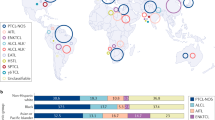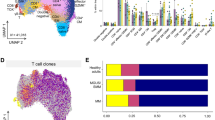Abstract
T-cell receptor (TCR) signaling is pivotal in T-cell development and function. In peripheral T-cell lymphomas/leukemias (PTCL/L), histogenesis, transforming events, epidemiology, and clinical presentation are also closely linked to TCR-mediated influences. After reviewing the physiology of normal TCR signaling and cellular responses, we describe here the association of subgroups of PTCL/L with specific patterns of TCR activation as relevant tumor-initiating and/or tumor-sustaining programs. We identify PTCL/L with a functionally intact TCR machinery in which stimulation is possibly incited by exogenous antigens or autoantigens. Distinct from these are tumors with autonomous oncogenic signaling by dysregulated TCR components uncoupled from extrinsic receptor input. A further subset is characterized by transforming events that activate molecules acting as substitutes for TCR signaling, but triggering similar downstream cascades. We finally discuss the consequences of such a functional model for TCR-targeted therapeutic strategies including those that are being tested in the clinic and those that still require further development.



Similar content being viewed by others
References
Papers of particular interest, published recently, have been highlighted as: • Of importance •• Of major importance
Swerdlow SH, Campo E, Harris NL, et al. WHO classification of tumours of haematopoietic and lymphoid tissue. Lyon: IARC; 2008.
Vose J, Armitage J, Weisenburger D. International peripheral T-cell and natural killer/T-cell lymphoma study: pathology findings and clinical outcomes. J Clin Oncol. 2008;26(25):4124–30.
• Pileri SA, Piccaluga PP. New molecular insights into peripheral T cell lymphomas. J Clin Invest. 2012;122(10):3448–55. This is an up-to-date review by experts from the European T-Cell Lymphoma Study Group on our current concepts of the molecular pathogenesis and histogenesis of major subsets of nodal peripheral T-cell lymphomas.
Smith-Garvin J, Koretzky G, Jordan M. T cell activation. Annu Rev Immunol. 2009;27:591–619.
Acuto O, Di Bartolo V, Michel F. Tailoring T-cell receptor signals by proximal negative feedback mechanisms. Nat Rev Immunol. 2008;8(9):699–712.
Baker M, Gamble J, Tooze R, et al. Development of T-leukaemias in CD45 tyrosine phosphatase-deficient mutant lck mice. EMBO J. 2000;19(17):4644–54.
Nakayama T, Yamashita M. The TCR-mediated signaling pathways that control the direction of helper T cell differentiation. Semin Immunol. 2010;22(5):303–9.
Jones D, O’Hara C, Kraus MD, et al. Expression pattern of T-cell-associated chemokine receptors and their chemokines correlates with specific subtypes of T-cell non-Hodgkin lymphoma. Blood. 2000;96(2):685–90.
Zhou L, Chong MMW, Littman DR. Plasticity of CD4+ T cell lineage differentiation. Immunity. 2009;30(5):646–55.
Létourneau S, Krieg C, Pantaleo G, Boyman O. IL-2- and CD25-dependent immunoregulatory mechanisms in the homeostasis of T-cell subsets. J Allergy Clin Immunol. 2009;123(4):758–62.
Boyman O, Létourneau S, Krieg C, Sprent J. Homeostatic proliferation and survival of naïve and memory T cells. Eur J Immunol. 2009;39(8):2088–94.
Surh CD, Sprent J. Homeostasis of naive and memory T cells. Immunity. 2008;29(6):848–62.
Krammer PH, Arnold R, Lavrik IN. Life and death in peripheral T cells. Nat Rev Immunol. 2007;7(7):532–42.
An J, Fujiwara H, Suemori K, et al. Activation of T-cell receptor signaling in peripheral T-cell lymphoma cells plays an important role in the development of lymphoma-associated hemophagocytosis. Int J Hematol. 2011;93(2):176–85.
Crispín JC, Tsokos GC. Transcriptional regulation of IL-2 in health and autoimmunity. Autoimmun Rev. 2009;8(3):190–5.
Burg G, Kempf W, Haeffner A, et al. From inflammation to neoplasia: new concepts in the pathogenesis of cutaneous lymphomas. Recent Results Cancer Res. 2002;160:271–80.
Kupper TS, Fuhlbrigge RC. Immune surveillance in the skin: mechanisms and clinical consequences. Nat Rev Immunol. 2004;4(3):211–22.
Morgan SM, Hodges E, Mitchell TJ, et al. Molecular analysis of T-cell receptor β genes in cutaneous T-cell lymphoma reveals Jβ1 bias. J Invest Dermatol. 2006;126(8):1893–9.
Hahtola S, Tuomela S, Elo L, et al. Th1 response and cytotoxicity genes are down-regulated in cutaneous T-cell lymphoma. Clin Cancer Res. 2006;12(16):4812–21.
Dummer R, Geertsen R, Ludwig E, Niederer E, Burg G. Sézary syndrome, T-helper 2 cytokines and accessory factor-1 (AF-1). Leuk Lymphoma. 1998;28(5–6):515–22.
Papadavid E, Economidou J, Psarra A, et al. The relevance of peripheral blood T-helper 1 and 2 cytokine pattern in the evaluation of patients with mycosis fungoides and Sézary syndrome. Br J Dermatol. 2003;148(4):709–18.
Abdulla F, Duvic M, Kim Y. T-cell lymphomas. Totowa, NJ: Humana Press; 2013.
Martínez-Delgado B, Cuadros M, Honrado E, et al. Differential expression of NF-κB pathway genes among peripheral T-cell lymphomas. Leukemia. 2005;19(12):2254–63.
Wlodarski MW, O’Keefe C, Howe EC, et al. Pathologic clonal cytotoxic T-cell responses: nonrandom nature of the T-cell-receptor restriction in large granular lymphocyte leukemia. Blood. 2005;106(8):2769–80.
Garrido P, Ruiz-Cabello F, Bárcena P, et al. Monoclonal TCR-Vβ13.1+/CD4+/NKa+/CD8-/+dim T-LGL lymphocytosis: evidence for an antigen-driven chronic T-cell stimulation origin. Blood. 2007;109(11):4890–8.
Lima M, Almeida J, Santos AH, et al. Immunophenotypic analysis of the TCR-vβ repertoire in 98 persistent expansions of CD3+/TCR-αβ + large granular lymphocytes. Am J Pathol. 2001;159(5):1861–8.
Sandberg Y, Almeida J, Gonzalez M, et al. TCRγ/δ + large granular lymphocyte leukemias reflect the spectrum of normal antigen-selected TCRγ/δ + T-cells. Leukemia. 2006;20(3):505–13.
O’Keefe CL, Plasilova M, Wlodarski M, et al. Molecular analysis of TCR clonotypes in LGL: a clonal model for polyclonal responses. J Immunol. 2004;172(3):1960–9.
Sandberg Y. Basic and clinical aspects of the T-cell receptor in mature T-cell malignancies. Ph.D. Thesis. Erasmus University Rotterdam; 2007. p. 221.
•• Clemente MJ, Wlodarski MW, Makishima H, et al. Clonal drift demonstrates unexpected dynamics of the T-cell repertoire in T-large granular lymphocyte leukemia. Blood. 2011;118(16):4384–93. This paper instructively shows for T-LGL what many researchers in the field of mature T-cell lymphomas have been observing, namely a marked clonal dynamics of retraction and expansion of various TCR-defined clones within one tumor. It also contributes particularly to our understanding of T-LGL representing a spectrum of gradual overlap between reactive lesions and overt malignant neoplasms.
Davey MP, Starkebaum G, Loughran TP. CD3+ leukemic large granular lymphocytes utilize diverse T-cell receptor Vβ genes. Blood. 1995;85(1):146–50.
Loughran TP, Hadlock KG, Perzova R, et al. Epitope mapping of HTLV envelope seroreactivity in LGL leukaemia. Br J Haematol. 1998;101(2):318–24.
Yawalkar N, Ferenczi K, Jones DA, et al. Profound loss of T-cell receptor repertoire complexity in cutaneous T-cell lymphoma. Blood. 2003;102(12):4059–66.
Jackow CM, Cather JC, Hearne V, et al. Association of erythrodermic cutaneous T-cell lymphoma, superantigen-positive Staphylococcus aureus, and oligoclonal T-cell receptor Vβ gene expansion. Blood. 1997;89(1):32–40.
Abrams JT, Balin BJ, Vonderheid EC. Association between Sézary T cell-activating factor, Chlamydia pneumoniae, and cutaneous T cell lymphoma. Ann N Y Acad Sci. 2001;941:69–85.
Tissier F, Martinon F, Camilleri-Broët S, et al. T-cell receptor Vβ repertoire in nodal non-anaplastic peripheral T-cell lymphomas. Pathol Res Pract. 2002;198(6):389–95.
Hodges E, Edwards SE, Howell WM, Smith JL. Polymerase chain reaction amplification analyses of clonality in T-cell malignancy including peripheral T-cell lymphoma. Leukemia. 1994;8(2):295–8.
Tembhare P, Yuan CM, Xi L, et al. Flow cytometric immunophenotypic assessment of T-cell clonality by Vβ repertoire analysis. Am J Clin Pathol. 2011;135(6):890–900.
•• Newrzela S, Al-Ghaili N, Heinrich T, et al. T-cell receptor diversity prevents T-cell lymphoma development. Leukemia. 2012;26(12):2499–507. Mature T cells have been considered to be largely resistant to (experimental) transformation by most known T-cell oncogenes. However, these researchers present data that indicate that in a background of clonal T-cell restriction, as for example observed during senescence or in lymphopenia, the outgrowth of mature T-cell lymphomas is facilitated. This supports a model in which homeostatic mechanisms that stabilize the diversity of the normal T-cell repertoire, e.g. clonal competition, also control the emergence of potentially malignant T-cell clones.
• Geissinger E, Sadler P, Roth S, et al. Disturbed expression of the T-cell receptor/CD3 complex and associated signaling molecules in CD30+ T-cell lymphoproliferations. Haematologica. 2010;95(10):1697–704. This study shows that severely altered expression of the TCR/CD3 complex, of TCR-associated transcription factors, and of signal transduction molecules is common and a shared characteristic in CD30 + T-cell lymphomas. This distinguishes these tumors from other subsets, e.g. PTCL-nos, and supports the TCR-based concept of a functional categorization of mature T-cell tumors outlined here.
Admirand J, Herling M, Patel K, et al. T-cell receptor signaling and growth pathways in T-cell tumors. Mod Pathol. 2005;18:220A.
Herling M, Patel KA, Teitell MA, et al. High TCL1 expression and intact T-cell receptor signaling define a hyperproliferative subset of T-cell prolymphocytic leukemia. Blood. 2008;111(1):328–37.
Herling M, Khoury JD, Washington LT, et al. A systematic approach to diagnosis of mature T-cell leukemias reveals heterogeneity among WHO categories. Blood. 2004;104(2):328–35.
Hoyer KK, Herling M, Bagrintseva K, et al. T cell leukemia-1 modulates TCR signal strength and IFN-γ levels through phosphatidylinositol 3-kinase and protein kinase c pathway activation. J Immunol. 2005;175(2):864–73.
Herling M, Patel KA, Weit N, et al. High TCL1 levels are a marker of B-cell receptor pathway responsiveness and adverse outcome in chronic lymphocytic leukemia. Blood. 2009;114(21):4675–86.
Streubel B, Vinatzer U, Willheim M, Raderer M, Chott A. Novel t(5;9)(q33;q22) fuses ITK to SYK in unspecified peripheral T-cell lymphoma. Leukemia. 2006;20(2):313–8.
Feldman AL, Sun DX, Law ME, et al. Overexpression of SYK tyrosine kinase in peripheral T-cell lymphomas. Leukemia. 2008;22(6):1139–43.
Travert M, Huang Y, De Leval L, et al. Molecular features of hepatosplenic T-cell lymphoma unravels potential novel therapeutic targets. Blood. 2012;119(24):5795–806.
Ortiz S, Lee W, Smith D, et al. Comparative analyses of differentially induced T-cell receptor-mediated phosphorylation pathways in T lymphoma cells. Exp Biol Med (Maywood). 2010;235(12):1450–63.
• Pechloff K, Holch J, Ferch U, et al. The fusion kinase ITK-SYK mimics a T-cell receptor signal and drives oncogenesis in conditional mouse models of peripheral T-cell lymphoma. J Exp Med. 2010;207(5):1031–44. In the context of the recurrence of the t(5;9)(q33;q22) in a subset of PTCL-nos and the frequently high levels of SYK across many mature T-cell tumors, these authors provide experimental evidence of the transforming capacity of the ITK-SYK fusion tyrosine kinase in peripheral T-cells. Their work supports our TCR-based model by showing that constitutive TCR signaling is a strong oncogenic force.
Dierks C, Adrian F, Fisch P, et al. The ITK-SYK fusion oncogene induces a T-cell lymphoproliferative disease in mice mimicking human disease. Cancer Res. 2010;70(15):6193–204.
Amin HM, Lai R. Pathobiology of ALK + anaplastic large-cell lymphoma. Blood. 2007;110(7):2259–67.
Armitage JO. The aggressive peripheral T-cell lymphomas: 2012 update on diagnosis, risk stratification, and management. Am J Hematol. 2012;87(5):511–9.
Hiromura M, Okada F, Obata T, et al. Inhibition of AKT kinase activity by a peptide spanning the βA strand of the proto-oncogene TCL1. J Biol Chem. 2004;279(51):53407–18.
Berger CL, Longley J, Hanlon D, Girardi M, Edelson R. The clonotypic T-cell receptor is a source of tumor-associated antigens in cutaneous T cell lymphoma. Ann N Y Acad Sci. 2001;941:106–22.
Acknowledgments
Support of relevance to this manuscript: Work on the biology of T-PLL by M.H. and N.W. has been awarded for continuation by a grant of the German José Carreras Leukemia Foundation. M.H. is funded by the German Research Foundation (DFG) under HE-3553/4-1 as part of the FOR-1961 collaborative research group ‘CONTROL-T’.
Compliance with Ethics Guidelines
ᅟ
Conflicts of Interest
Kathrin Warner declares that she has no conflict of interest.
Nicole Weit has been employed by Beckman Coulter GmbH since 2012.
Giuliano Crispatzu declares that he has no conflict of interest.
Joan Admirand declares that she has no conflict of interest.
Dan Jones works at Quest Diagnostics and has received research grants from NIH, and royalties from MD Anderson Cancer Center.
Marco Herling declares that he has no conflict of interest.
Human and Animal Rights and Informed Consent
This article does not contain any studies with human or animal subjects performed by any of the authors.
Author information
Authors and Affiliations
Corresponding author
Electronic Supplementary Material
Below is the link to the electronic supplementary material.
ESM 1
(DOCX 32 kb)
Rights and permissions
About this article
Cite this article
Warner, K., Weit, N., Crispatzu, G. et al. T-Cell Receptor Signaling in Peripheral T-Cell Lymphoma – A Review of Patterns of Alterations in a Central Growth Regulatory Pathway. Curr Hematol Malig Rep 8, 163–172 (2013). https://doi.org/10.1007/s11899-013-0165-2
Published:
Issue Date:
DOI: https://doi.org/10.1007/s11899-013-0165-2




